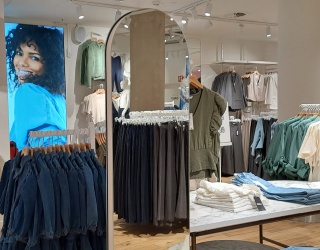
Wide aisles in the store, customers are supposed to make their selections without hurrying. Yet at the checkout things get tight and everything is supposed to go fast. At the supermarket, cashiers scan over 80 items per minute. Stress, responsibility and repetitious motions put a strain on their health. Ergonomics at the cashier station is an investment that pays off.
”Health protection is not just a financial issue. It also shows appreciation towards personnel and thus contributes to employee motivation“, says Dr. Bernward Siebert, Chairman of the Berlin Chapter of the German Association of Company Physicians (www.vdbw.de). “A lot of things have gotten better in business over the past few years“, he summarizes. Siebert works at the Occupational Medicine Office of the German Technical Inspection Agency, which gives advice to companies from various industry sectors.
According to Siebert, today fewer cashiers are exposed to drafts in entrance ways. Discount stores save energy through vestibules at the entrance and cashier stations are also shielded by transparent rear panels. In many commercial enterprises the awareness of the value of good employees is growing. He is concerned about some small specialty stores though that don’t even have a common break room.
Improvements don’t have to be expensive. Siebert suggests for example to outfit larger beverage packages with a barcode that can be torn off. A label can alert the customers that they don’t have to lift the packages onto the conveyor belt and only need to present the tag with the lines on it. “This would help out both sides, customers and employees alike – and scanning the items would speed things up even more“, he argues. “Retailers would simply need to put some pressure on the bottling companies. “
Sick slips for many different reasons
Making a good case – that’s what occupational physicians can do. They don’t have authority over companies that hire them based on statutory provisions. They give advice to employers and this way can help to reduce the number of sick slips. A cause study isn’t always easy, after all a cashier rarely will call in sick due to back pain if she doesn’t want to risk losing her job. Instead, the flu or a migraine is stated as the reason. “Far too few family doctors ask about the situation on the job“, Siebert criticizes.
There are precise directives for designing cashier work stations including placement of merchandise, equipment and operating controls. “There are over 300 pages written by the workers‘compensation board“, estimates Hartwin Tackenberg, owner of the cash desk company in Bochum by the same name (www.tackenberg.eu). Tackenberg does not build up cash desk reserves, but builds according to the requirements of companies and directives. “But all directives are useless, if the company doesn’t implement them“, he explains.
Retailers analyze all work processes to the split second, looking for savings potential. They also use anthropometri¬c data, dimensional ratios of the human body. Since it’s mostly women that work at checkouts, you often pull up the standard data for women. “The difference in size among women however is huge“, says Siebert. Of great importance are the visual field and radius for picking up items, but also operating spaces and the possibility to do balancing movements both while sitting or standing up. It is not enough to just pay attention to the height of the work space, because the size of products is also important. The larger the items, the lower the work space should be.
Many cashiers suffer from psychological strain, stress due to transaction processing and the quickly changing customer contact. Aches in the supporting apparatus and locomotor system are very common. The spine, as well as the back – and neck muscles are under a lot of strain. When a personal sits non-stop, the legs are sorely taxed, in jobs that require a lot of standing, blood vessels are a sore point.
Change is healthier
So do you want a cash register where you sit or where you have to stand up? From an occupational medical point of view a combination would be ideal – meaning a flexible cash register working space that each associate can adjust during working hours with a few easy moves to their specific height and requirements. Such cash desks are rare in food retailing. However, these types of models by Tackenberg can be seen in food departments of Karstadt Department stores. Customers might have to lift their items up a little higher to place them on the belt.
The constant repetitions of fairly easy processes turn into health issues. The human arm weighs about three- and one half kilos explains occupational physician Siebert. If a cashier has to insert the cash card a hundred times per day into the terminal with outstretched arms and then needs to swivel it toward the customers for them to enter their PIN, it all adds up to intense stress. And often the items come from the right on the conveyor belt, so the right arm moves the items along over several hours.
At the next EuroShop, cash desk manufacturers will also showcase how retailers can create more comfortable processes. Several exhibitors will present sturdy stands for the hardware for checkouts, keyboard, display, card terminal and receipt printer that will afford certain freedoms for employees. Omni-directional scanners make entries easier and staff needs to turn items less than before to look for the barcode. The articles can be pulled across the reading device in different directions.
Dr. Bernward Sieber, occupational physician, makes one pragmatic suggestion: “The employees in stores should take turns with activities more often“. Stocking shelves – in part done reaching overhead or across freezers with the outstretched upper part of the body – in the long run amounts to heavy work. This also applies to stacks of cardboard boxes in a shoe store, at the fashion boutique or sports outfitter.
René Schellbach, EuroShop.de






